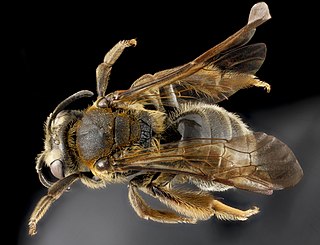 W
WThe Appalachian miner bee is a species of miner bee in the family Andrenidae. Another common name for this species is Alleghany andrena. It is found in North America.
 W
WThe Bradley's miner bee is a species of miner bee in the family Andrenidae. Another common name for this species is Bradley's andrena. It is found in North America.
 W
WAndrena cornelli, the azalea miner, is a species of mining bee in the family Andrenidae. It is found in North America. The only bee species oligolectic on azalea with widely spaced scopa hairs that can carry the type of pollen of these plants.
 W
WAnthidium tenuiflorae is a species of bee in the family Megachilidae, the leaf-cutter, carder, or mason bees.
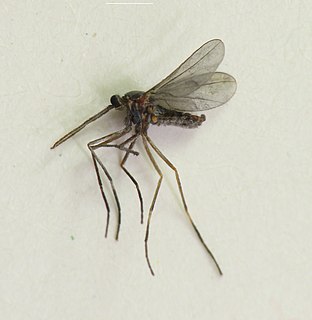 W
WAsphondylia solidaginis is a species of gall midges in the family Cecidomyiidae.
 W
WAustrophlebia costalis, the southern giant darner, is a species of dragonfly in the family Telephlebiidae endemic to eastern Australia.
 W
WBoyeria grafiana, the ocellated darner, is a species of darner in the dragonfly family Aeshnidae. It is found in North America.
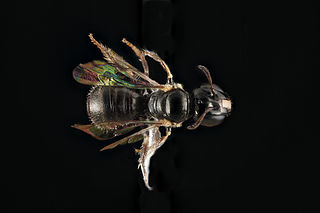 W
WCeratina cockerelli, or Cockerell's ceratina, is a species of carpenter bee in the family Apidae. It is found in the Caribbean Sea and North America.
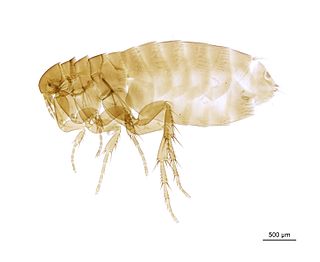 W
WCeratophyllus borealis , also known as the boreal flea, is an ectoparasite of birds. It is a black species found on ground-nesting birds such as pipits, wheatears and wagtails.
 W
WConozoa carinata, the ridged grasshopper, is a species of band-winged grasshopper in the family Acrididae. It is found in Central America and North America.
 W
WCyrtoxipha columbiana, the Columbian trig, is a species of winged bush crickets, trigs in the family Gryllidae.
 W
WDasineura carbonaria is a species of gall midges in the family Cecidomyiidae.
 W
WDendroaeschna is a monotypic genus of Australian dragonflies in the family Brachytronidae. The only known species of this genus is Dendroaeschna conspersa, commonly known as a wide-faced darner.
 W
WDilta hibernica is a species of jumping bristletail in the family Machilidae. It is found in Europe.
 W
WDinocras is a genus of stoneflies belonging to the family Perlidae, one of the oldest order of insects.
 W
WDiphlebia euphoeoides, sometimes spelled Diphlebia euphaeoides, known as the tropical rockmaster, is an Australian species of broad winged damselfly. It is one of a group known as the azure damselflies. It is found in Queensland (Australia) and Papua New Guinea. It typically occurs near lakes, waterfalls or streams at relatively low altitudes, and is occasionally seen near dry pools.
 W
WDoleromyrma darwiniana is a species of ant in the genus Doleromyrma. Described by Forel in 1907, the species is endemic to Australia and introduced to New Zealand, and it nests in soil or under stones and logs. The organism grows to a length between 2.0 and 3.0 millimeters. This species of ant maintains small colony sizes and it "prefers protein food." The species is also known by some sources as the "brown house ant" and "Darwin's ant". The species is considered a "minor urban pest" in New South Wales.
 W
WDromaeschna forcipata is a species of dragonfly in the family Telephlebiidae, known commonly as the green-striped darner. It generally inhabits streams in coastal rainforests of north-eastern Queensland, Australia.
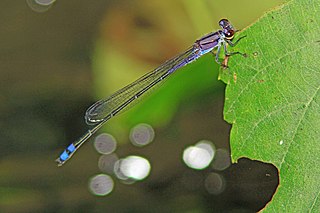 W
WEnallagma novaehispaniae, the neotropical bluet, is a species of narrow-winged damselfly in the family Coenagrionidae. It is found in Central America, North America, and South America.
 W
WHemicordulia continentalis is a species of dragonfly in the family Corduliidae, known as the fat-bellied emerald. It inhabits pools, lakes, ponds and swamps in coastal Queensland and northern New South Wales, Australia.
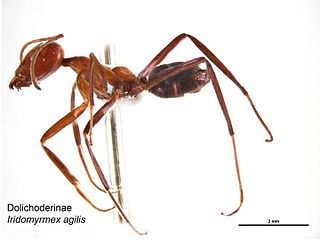 W
WIridomyrmex agilis is an ant of the genus Iridomyrmex. They are distributed throughout most of Australia. They are usually found in the drier regions of Australia. The species was described by Forel in 1907.
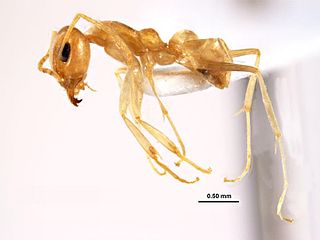 W
WIridomyrmex exsanguis is a species of ant in the genus Iridomyrmex. Described by Forel in 1907, the species is distributed nationwide in Australia.
 W
WIridomyrmex hartmeyeri is a species of ant in the genus Iridomyrmex. Described by Forel in 1907, the ant is a nocturnal forager, and it distributed in most of Australia.
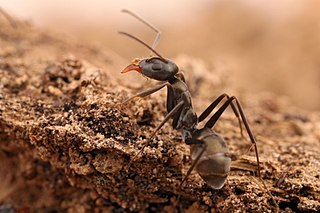 W
WIridomyrmex splendens is a species of ant in the genus Iridomyrmex. Described by Forel in 1907, the ant is mainly distributed in the southern regions of Australia, commonly found in dry sclerophyll woodland, and nests are found under logs.
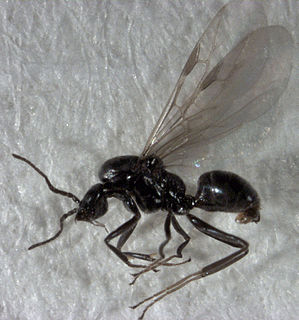 W
WIridomyrmex suchieri is a species of ant in the genus Iridomyrmex. Described by Forel in 1907, the species is endemic to Australia, but has also been recorded from New Zealand.
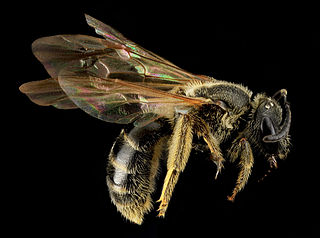 W
WLasioglossum quebecense is a species of sweat bee in the family Halictidae.
 W
WLibellula comanche, the Comanche skimmer, is a species of skimmer in the family Libellulidae. It is found in Central America and North America.
 W
WLinepithema keiteli is a species of ant in the genus Linepithema. Described by Forel in 1907, the species is endemic to Haiti.
 W
WMedauroidea extradentata, commonly known as the Vietnamese or Annam walking stick, is a species of the family Phasmatidae. They originate in Vietnam and are commonly found in tropical forests there. They eat a variety of foliage, though in captivity they commonly eat blackberry bramble, hawthorn, oak, red maple, and rose.
 W
WMegachile macleayi is a species of bee in the family Megachilidae. It was described by Theodore Dru Alison Cockerell in 1907.
 W
WMegachile maculariformis is a species of bee in the family Megachilidae. It was described by Theodore Dru Alison Cockerell in 1907.
 W
WMyrmecia michaelseni is an Australian ant which belongs to the genus Myrmecia. This species is native to Australia. They are mostly distributed and studied in Western Australia.
 W
WThe Neobarrettia spinosa, also known as greater arid-land katydid, red eyed katydid, giant Texas katydid, is a cricket of the katydid family, Tettigoniidae, that is native to west-southern United States and northern Mexico.
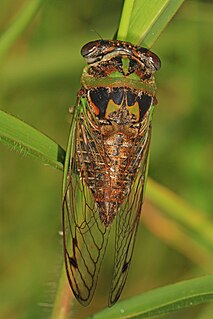 W
WNeotibicen davisi, known generally as the Davis' southeastern dog-day cicada or southern dog-day cicada, is a species of cicada in the family Cicadidae.
 W
WNeotibicen linnei, commonly called Linne's cicada, is a species of large bodied annual cicada in the genus Neotibicen. It is native to the Eastern United States and Canada. N. linnei in Oklahoma is most easily identified by the coastal margin bent at the end of the radial cell and opercula truncated obliquely at the extremities.
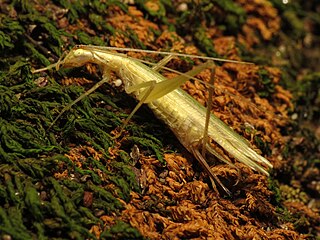 W
WOecanthus exclamationis is a "common tree cricket" in the subfamily Oecanthinae. A common name for O. exclamationis is Davis' tree cricket. It is found in North America.
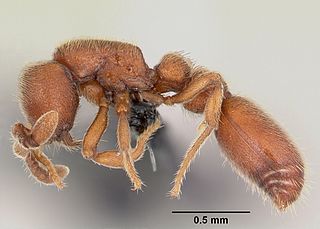 W
WOoceraea biroi, the clonal raider ant, is a queenless clonal ant in the genus Ooceraea. Native to the Asian mainland, this species has become invasive on tropical and subtropical islands throughout the world. Unlike most ants, which have reproductive queens and mostly nonreproductive workers, all individuals in a O. biroi colony reproduce clonally via thelytokous parthenogenesis. Like most dorylines, O. biroi are obligate myrmecophages and raid nests of other ant species to feed on the brood.
 W
WPameridea roridulae is a species of jumping tree bug in the family Miridae.
 W
WPheidole jonas is a species of ant in the subfamily Myrmicinae.
 W
WPhobaeticus kirbyi is a very long stick insect native to Borneo. The holotype deposited at the Natural History Museum in London measures 328 mm (12.9 in) excluding legs and 546 mm (21.5 in) including legs. This makes it the second-longest known insect in terms of body length, behind Phobaeticus chani with 357 mm (14.1 in). Both P. chani and Phobaeticus serratipes exceed it in total length with legs extended. However, recent specimens of P. kirbyi have only reached 283 mm (11.1 in) in body length.
 W
WPlaniplax sanguiniventris, the Mexican scarlet-tail, is a species of skimmer in the dragonfly family Libellulidae. It is found in Central America.
 W
WProcordulia is a genus of dragonfly in the family Corduliidae. Procordulia are found in Southeast Asia, New Guinea, Australia, New Zealand and parts of the Pacific region.
 W
WPteronarcys princeps, the ebony salmonfly, is a species of giant stonefly in the family Pteronarcyidae. It is found in North America.
 W
WRhopalomyia clarkei is a species of gall midges, insects in the family Cecidomyiidae.
 W
WSericomyia lata is a species of syrphid fly in the family Syrphidae.
 W
WSogatella kolophon is a species of delphacid planthopper in the family Delphacidae. It is found in Africa, Australia, the Caribbean, Central America, North America, Oceania, South America, and Southern Asia.
 W
WSomatochlora williamsoni, or Williamson's emerald, is a species of emerald dragonfly in the family Corduliidae. It is found in North America.
 W
WTarachodes sjostedti is a species of praying mantis in the genus Tarachodes.
 W
WTemnostethus gracilis is a species of minute pirate bug in the family Anthocoridae. It is found in Europe and across the Palearctic to the Caucasus and Siberia and North America.
 W
WToxoptera citricida is a species of aphid known by the common names brown citrus aphid, black citrus aphid, and oriental citrus aphid. It is a pest of citrus and vector for the pathogenic plant virus citrus tristeza virus. The aphid spread the virus through citrus groves in Brazil and Venezuela in the 1970s, leading to the near destruction of the citrus industry there. This aphid was first discovered in Florida in 1995.